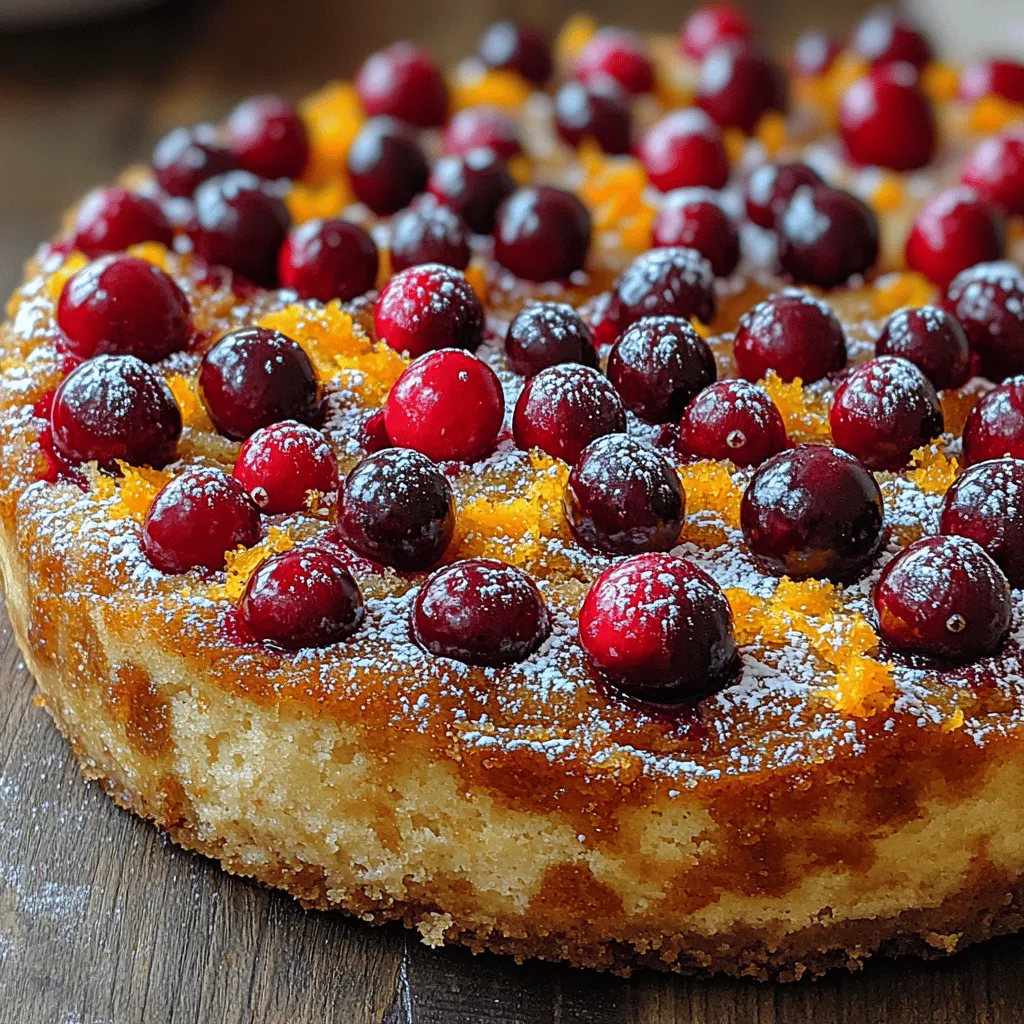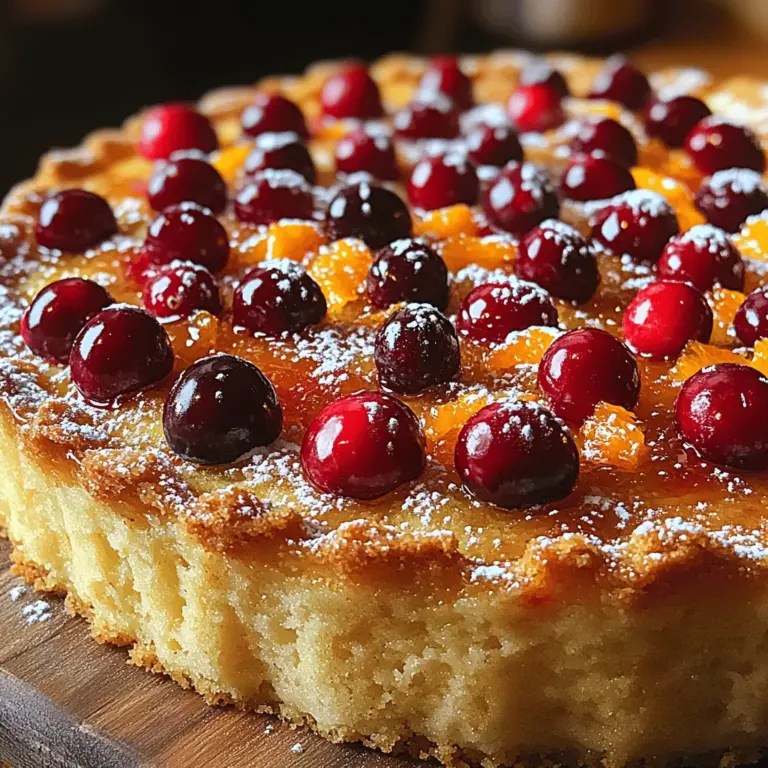Introduction
There’s something inherently comforting about breakfast cakes. They effortlessly bridge the gap between breakfast and dessert, offering a sweet start to your day or a delightful treat for a midday coffee break. Breakfast cakes are not only easy to prepare but also serve as the perfect canvas for a variety of flavors. Today, we introduce you to a standout breakfast delight: the Cranberry and Orange Buttermilk Breakfast Cake. This cake beautifully embodies the essence of morning indulgence, boasting a harmonious balance of tangy cranberries and the bright zest of fresh oranges.
What sets this cake apart is its incredible texture, achieved through the use of buttermilk, which not only adds moisture but also contributes to a tender crumb. The addition of fresh cranberries and zesty orange elevates it beyond the ordinary, creating a cake that’s flavorful, fragrant, and visually appealing. Whether you’re hosting a brunch, celebrating a special occasion, or simply want to treat yourself to a delicious homemade breakfast, this cake is versatile enough to shine in any setting.
As we delve into this recipe, you’ll discover how the blend of tart cranberries and sweet citrus creates a delightful contrast that pleases the palate. The cake is not overly sweet, allowing the natural flavors of the ingredients to take center stage. It’s the perfect complement to a cup of coffee or tea and can even be enjoyed on its own. Now, let’s explore the ingredients that make this breakfast cake a true masterpiece.
Understanding the Ingredients
Every great cake begins with quality ingredients, and the Cranberry and Orange Buttermilk Breakfast Cake is no exception. Each element plays a crucial role in developing flavor, texture, and overall appeal. Here’s a closer look at each ingredient:
All-Purpose Flour: The Foundation of Your Cake
All-purpose flour serves as the backbone of any cake recipe, including our cranberry and orange delight. It provides structure, ensuring the cake rises beautifully while maintaining a soft texture. When measuring flour, it’s critical to do so accurately, as too much can lead to a dense cake. To measure flour properly, use a spoon to fluff it up in the container, then spoon it into your measuring cup without packing it down. For an even lighter cake, consider sifting the flour before use, which aerates it and removes any lumps.
Baking Powder and Baking Soda: The Leavening Agents
In baking, achieving the right texture is essential, and this is where leavening agents like baking powder and baking soda come into play. Baking powder is a complete leavening agent that contains both an acid and a base, allowing it to create carbon dioxide bubbles when combined with moisture and heat. This is what makes your cake rise and become fluffy.
On the other hand, baking soda requires an acidic ingredient to activate it, which in this recipe is provided by the buttermilk and the citric acid in the orange juice. Both agents are crucial for achieving the desired lightness in your cake, so ensure they are fresh for optimal results.
Salt: Elevating Flavors
While it may seem counterintuitive to add salt to a sweet recipe, it’s an essential component that elevates the overall flavor profile of the cake. A small amount of salt enhances the sweetness and balances the tartness of the cranberries, allowing the flavors to shine through. It also plays a role in strengthening the cake’s structure by tightening the gluten strands formed during mixing.
Unsalted Butter: Creaminess and Flavor
Butter is a vital ingredient that adds richness and flavor to baked goods. For this recipe, it’s important to use unsalted butter, as it allows you to control the salt content of your cake. Ensure your butter is softened to room temperature before creaming it with sugar; this will help incorporate air into the mixture, resulting in a light and fluffy texture. The creaminess of the butter also contributes to the cake’s moistness, making each bite a delightful experience.
Granulated Sugar: Sweetness and Structure
Granulated sugar not only sweetens the cake but also contributes to its structure and moisture. When sugar is creamed with butter, it creates tiny air pockets that help the cake rise. Additionally, sugar caramelizes during baking, giving the cake a beautiful golden color and enhancing its flavor profile. In this recipe, the balance of sugar is key; it should complement the tartness of the cranberries without overwhelming the cake.
Eggs: Binding and Enriching
Eggs are indispensable in baking, as they provide moisture, richness, and stability. They act as a binder, holding all the ingredients together and ensuring a uniform texture. In our breakfast cake, eggs also contribute to the leavening process, helping to create a light and airy crumb. For best results, use large eggs at room temperature, as they mix more easily into the batter.
Citrus Zest and Juice: Brightness and Freshness
The star flavors of this cake come from the bright and zesty orange. Freshly grated orange zest adds an aromatic quality that enhances the cake’s taste, while the juice provides acidity that balances the sweetness. Using fresh juice instead of bottled ensures a vibrant flavor, so take the time to grate and juice your oranges before mixing them into the batter. The citrus elements invigorate the cake, making it a refreshing choice for breakfast.
Buttermilk: Tenderness and Flavor
Buttermilk is a key ingredient that not only adds flavor but also helps to tenderize the cake. Its acidity reacts with the baking soda, creating a lovely rise in the cake while keeping it moist and tender. If you don’t have buttermilk on hand, you can easily make a substitute by mixing milk with a splash of vinegar or lemon juice. Allow it to sit for a few minutes before using it in your recipe.
Cranberries: Tartness and Color
Cranberries offer a delightful burst of tartness that contrasts beautifully with the sweetness of the cake. You can use fresh or frozen cranberries in this recipe, though fresh cranberries provide a firmer texture and bright flavor. If using frozen, make sure to thaw and drain them to avoid excess moisture in your cake. Rinsing the cranberries before adding them to the batter will also help to remove any bitterness.
Brown Sugar: Caramelized Topping
To add a caramelized crust to your breakfast cake, brown sugar is an excellent choice. Its molasses content contributes a rich, deep flavor that complements the tart cranberries and sweet orange. Sprinkling brown sugar on top before baking creates a delightful contrast in texture, providing a sweet, crispy layer that enhances the overall eating experience.
Step-by-Step Instructions for Baking
Now that we’ve explored the key ingredients that make up this delectable breakfast cake, it’s time to dive into the step-by-step instructions for baking. Following these guidelines will ensure that your Cranberry and Orange Buttermilk Breakfast Cake turns out perfectly every time.
1. Preheat Your Oven: Start by preheating your oven to 350°F (175°C). This ensures that your cake bakes evenly and rises properly.
2. Prepare Your Baking Pan: Grease a 9-inch round cake pan with butter or non-stick cooking spray. For an extra layer of protection, you can line the bottom with parchment paper. This will make it easier to remove the cake once baked.
3. Mix the Dry Ingredients: In a medium bowl, whisk together the all-purpose flour, baking powder, baking soda, and salt. This step helps to evenly distribute the leavening agents throughout the flour.
4. Cream Butter and Sugar: In a large mixing bowl, use an electric mixer to cream the softened unsalted butter and granulated sugar until the mixture is light and fluffy. This process usually takes about 3-5 minutes and is crucial for incorporating air into the batter.
5. Add Eggs and Citrus: Beat in the eggs one at a time, ensuring that each is fully incorporated before adding the next. Then, mix in the orange zest and juice, combining until smooth.
6. Combine Dry and Wet Ingredients: Gradually add the dry ingredient mixture to the wet ingredients, alternating with the buttermilk. Start and end with the dry ingredients, mixing only until just combined. Be careful not to overmix, as this can result in a dense cake.
7. Fold in the Cranberries: Gently fold in the cranberries, being mindful not to crush them. This will help maintain their shape and allow for bursts of tartness throughout the cake.
8. Transfer to the Baking Pan: Pour the batter into the prepared cake pan, smoothing the top with a spatula. Sprinkle the brown sugar evenly over the top for that delightful caramelized finish.
9. Bake: Place the cake in the preheated oven and bake for 35-40 minutes or until a toothpick inserted into the center comes out clean. The edges should be lightly golden, and the cake should spring back when lightly pressed.
10. Cool and Serve: Once baked, remove the cake from the oven and allow it to cool in the pan for about 10 minutes before transferring it to a wire rack to cool completely. This will help set the structure and flavors.
Now that you have a clear understanding of the ingredients and initial steps involved in making the Cranberry and Orange Buttermilk Breakfast Cake, you’re well on your way to creating a delightful breakfast treat. Each step builds upon the last, ensuring that your cake emerges perfectly baked, moist, and bursting with flavor. Stay tuned for more detailed tips and serving suggestions in the subsequent sections!


